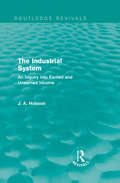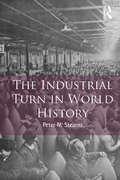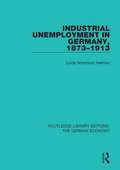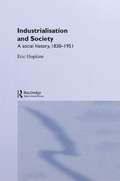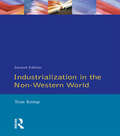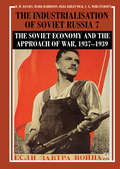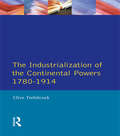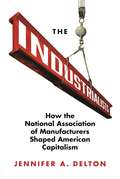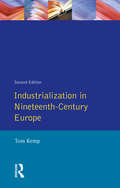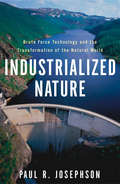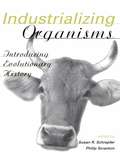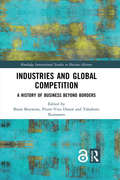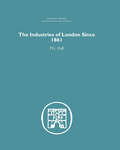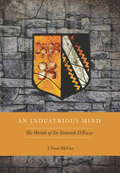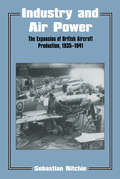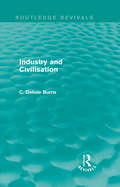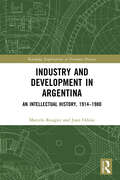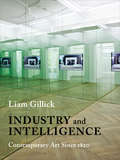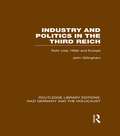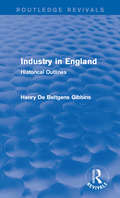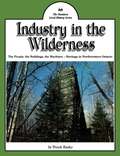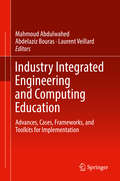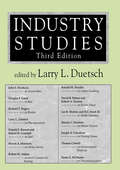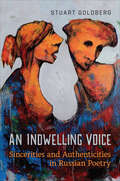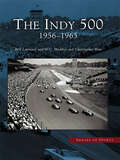- Table View
- List View
The Industrial System: An Inquiry into Earned and Unearned Income (Routledge Revivals)
by J. A. HobsonFirst published in 1909 and reissued in 1910, J. A. Hobson’s The Industrial System provides a complex analysis of distribution and consumption. Offering a critique of contemporary capitalism whilst accepting the superiority of the free market, the book includes an exploration of areas such as cost and surplus, supply and demand and the labour movement. This is an important work by one of the most important economic thinkers of the twentieth century, which will be of particular interest to modern economic historians.
The Industrial Turn in World History (Themes in World History)
by Peter StearnsIn The Industrial Turn in World History, Peter N. Stearns presents a concise yet far reaching overview of the worldwide shift from agricultural societies to industrial societies over the past two centuries. Putting the implications for individuals and societies in global context while simultaneously considering the limits of generalization across cultures, Stearns’s text explores the nature of industrialization across national and regional lines. Rather than portraying the Industrial Revolution as primarily a Western, early 19th-century development, this new narrative argues that the move to industrial societies is an ongoing and truly global shift. Taking a largely social and cultural approach, Stearns engages with the leading-edge approach of looking at emotion historically—allowing readers to ask questions about the impact of industrial society on emotional experience and happiness levels. This innovating framing allows for use in a variety of courses, including world history, economic history, and more general courses on the Industrial Revolution.
Industrial Unemployment in Germany 1873-1913 (Routledge Library Editions: The German Economy #5)
by Linda A. HeilmanOriginally published in 1991 this book provides a multi-faceted analysis of German unemployment between 1873 and 1913. It can also be read as an example of social scientific historiography during the fourth quarter of the twentieth century. Finally, the study has value for the comparative perspective it lends to current economic, social, and political turmoil in Germany, Europe, and the United States. While the precise conditions in the USA differ today, there are clearly still lessons to be learned on both sides of the Atlantic from the economic, social, and political dislocation, which accompanied industrial unemployment in Germany between 1873 and 1913. .
Industrialisation and Society: A Social History, 1830-1951
by Eric HopkinsIndusrialisation and Society provides an essential introduction to the effects of industrialisation on British society, from Queen Victoria's reign to the birth of the welfare state in the 1940s.This book deals with the remarkable social consequences of the industrial revolution, as Britain changed into an urban society based on industry. As the first nation to undergo an industrial revolution, Britain was also the first to deal with the unprecedented social problems of rapid urbanisation combined with an unparalleled growth in population.Industrialisation and Society looks at contemporary ways in which the government and ordinary people tried to cope with these new pressures, and studies their reactions to the unforseen consequences of the steam revolution. In particular, this indispensable book considers:* the Victorian inheritance* Edwardian England and the Liberal reforms* the two world wars* the Welfare State.
Industrialisation in the Non-Western World
by Tom KempThis new edition is fully updated and revised, incorporating the massive changes in the USSR and China in the 1980's. It offers a series of case-studies charting the progress and assessing the achievement of six industrializing countries outside the Western World. It covers the whole range of economic approaches, from those depending wholly on market forces to those that are completely planned.
The Industrialisation of Soviet Russia Volume 7: The Soviet Economy and the Approach of War, 1937–1939
by R. W. Davies Mark Harrison Oleg Khlevniuk Stephen G. WheatcroftThis book concludes The Industrialisation of Soviet Russia, an authoritative account of the Soviet Union’s industrial transformation between 1929 and 1939. The volume before this one covered the ‘good years’ (in economic terms) of 1934 to 1936. The present volume has a darker tone: beginning from the Great Terror, it ends with the Hitler-Stalin pact and the outbreak of World War II in Europe. During that time, Soviet society was repeatedly mobilised against internal and external enemies, and the economy provided one of the main arenas for the struggle. This was expressed in waves of repression, intensive rearmament, the increased regimentation of the workforce and the widespread use of forced labour.
Industrialisation of the Continental Powers 1780-1914, The
by Clive TrebilcockThe Industrialisation of the Continental Powers is both a broad survey of the process of European industrialisation from the late eighteenth century to the First World War, and also a closely argued comparative economic study of how this process was experienced by different great powers.
The Industrialists: How the National Association of Manufacturers Shaped American Capitalism (Politics and Society in Modern America #138)
by Jennifer A. DeltonThe first complete history of US industry's most influential and controversial lobbyistFounded in 1895, the National Association of Manufacturers—NAM—helped make manufacturing the basis of the US economy and a major source of jobs in the twentieth century. The Industrialists traces the history of the advocacy group from its origins to today, examining its role in shaping modern capitalism, while also highlighting the many tensions and contradictions within the organization that sometimes hampered its mission.In this compelling book, Jennifer Delton argues that NAM—an organization best known for fighting unions, promoting "free enterprise," and defending corporate interests—was also surprisingly progressive. She shows how it encouraged companies to adopt innovations such as safety standards, workers' comp, and affirmative action, and worked with the US government and international organizations to promote the free exchange of goods and services across national borders. While NAM's modernizing and globalizing activities helped to make American industry the most profitable and productive in the world by midcentury, they also eventually led to deindustrialization, plant closings, and the decline of manufacturing jobs.Taking readers from the Progressive Era and the New Deal to the Reagan Revolution and the Trump presidency, The Industrialists is the story of a powerful organization that fought US manufacturing's political battles, created its economic infrastructure, and expanded its global markets—only to contribute to the widespread collapse of US manufacturing by the close of the twentieth century.
Industrialization in Nineteenth Century Europe
by Tom KempWritten for the layman as well as the economic historian this famous and much-used book not only presents a general synthesis of the pattern of European industrialisation; it also provides material for a comparative study by illustrating, in separate case studies, the specific characteristics of development in Britain, France, Germany, Russia and Italy.
Industrialized Nature: Brute Force Technology and the Transformation of the Natural World
by Paul JosephsonThe construction of the Three Gorges Dam on China's Yangtze River. The transformation of the Amazon into a site for huge cattle ranches and aluminum smelters. The development of Nevada's Yucca Mountain into a repository for nuclear waste. The extensive irrigation networks of the Grand Coulee and Kuibyshev Dams. On the face of it, these massive projects are wonders of engineering, financial prowess, and our seldom-questioned ability to modify nature to suit our immediate needs. For nearly a century we have relied increasingly on science and technology to harness natural forces, but at what environmental and social cost?In Industrialized Nature, historian Paul R. Josephson provides an original examination of the ways in which science, engineering, policy, finance, and hubris have come together, often with unforeseen consequences, to perpetuate what he calls "brute-force technologies"--the large-scale systems created to manage water, forest, and fish resources. Throughout the twentieth century, nations with quite different political systems and economic orientations all pursued this same technological subjugation of nature. Josephson compares the Soviet Union's heavy-handed efforts at resource management to similar projects undertaken in the United States, Norway, Brazil, and China. He argues that brute-force technologies require brute-force politics to operate. He shows how irresponsible--or well-intentioned but misguided--large-scale manipulation of nature has resulted in resource loss and severe environmental degradation.Josephson explores the ongoing industrialization of nature that is happening in our own backyards and around the world. Both a cautionary tale and a call to action, Industrialized Nature urges us to consider how to develop a future for succeeding generations that avoids the pitfalls of brute-force technologies.
Industrializing Organisms: Introducing Evolutionary History (Hagley Perspectives on Business and Culture #Vol. 5)
by Susan R. Schrepfer Philip ScrantonFirst Published in 2004. Routledge is an imprint of Taylor & Francis, an informa company.
Industries and Global Competition: A History of Business Beyond Borders (Routledge International Studies in Business History)
by Pierre-Yves Donzé Bram Bouwens Takafumi KurosawaChanges in the dynamics of economic activities since the last decades of the 20th century have yielded major changes in the composition of industries and the division of labor and production across different regions of the world. Despite these shifts in the global economy, some industries have remained competitive even without relocating their operations overseas. Industries and Global Competition examines how and why the specificities of certain industries and firms determined their choice of location and competitiveness. This volume identifies the major drivers of this process and explains why some firms and industries moved to other parts of world while others did not. Relocation was not the sole determinant of the success or failure of firms and industries. Indeed some were able to reinvent themselves at their original location and build new competitive advantages. The path that each industry or firm took varied. This book argues that the specific characteristics of each industry defined the conditions of competitiveness and provide a wide range of cases as illustrations. Aimed at scholars, researchers and acadmeics in the fields of business history, international business and related disciplines Industries and Global Competition exmaines the unique questions; How and why did the specificities of certain industries and firms determine their choice of location and competitiveness?
Industries of London Since 1861
by P.G. HallFirst Published in 2005. Routledge is an imprint of Taylor & Francis, an informa company.
An Industrious Mind: The Worlds of Sir Simonds D'Ewes
by J. Sears McgeeThis is the first biography of Sir Simonds D'Ewes, a member of England's Long Parliament, Puritan, historian and antiquarian who lived from 1602-1650. D'Ewes took the Puritan side against the supporters of King Charles I in the English Civil War, and his extensive journal of the Long Parliament, together with his autobiography and correspondence, offer a uniquely comprehensive view of the life of a seventeenth-century English gentleman, his opinions, thoughts and prejudices during this tumultuous time. D'Ewes left the most extensive archive of personal papers of any individual in early modern Europe. His life and thought before the Long Parliament are carefully analyzed, so that the mind of one of the Parliamentarian opponents of King Charles I's policies can be understood more fully than that of any other Member of Parliament. Although conservative in social and political terms, D'Ewes's Puritanism prevented him from joining his Royalist younger brother Richard during the civil war that began in 1642. D'Ewes collected one of the largest private libraries of books and manuscripts in England in his era and used them to pursue historical and antiquarian research. He followed news of national and international events voraciously and conveyed his opinions of them to his friends in many hundreds of letters. McGee's biography is the first thorough exploration of the life and ideas of this extraordinary observer, offering fresh insight into this pivotal time in European history.
Industry and Air Power: The Expansion of British Aircraft Production, 1935-1941 (Studies in Air Power #Vol. 5)
by Noel Sebastian Ritchie Sebastian RitchieThe author begins with a general survey of British aircraft manufacturing in the inter-war period. Policy, production, finance and contracts are examined, and the final chapter is concerned with the mobilization of the aircraft industry in 1939, and the emergency measures of 1940.
Industry and Civilisation (Routledge Revivals)
by C. Delisle BurnsOriginally published in 1925, Industry and Civilisation explores moral standards and ethics related to economic activities by providing a comprehensive view of psychological data obtained from the business world. As well as exploring general ethics and psychology, this work also focusses on the principles underlying economic legislation and how this impacted on moral standards of the time. This title will be of interest to students of Business and Economics.
Industry and Development in Argentina: An Intellectual History, 1914–1980 (Routledge Explorations in Economic History)
by Marcelo Rougier Juan OdisioThis book explores the twists and turns in Argentina’s modern economic history and the debates that raged there around a problem common to all former colonies: how to achieve a level of economic growth for its population in a world characterized by unequal economic relations between the industrialized nations of the north and the commodity producers of the south. This new perspective examines the history of ideas surrounding industrialization and economic development in Argentina, drawing on a rigorous investigation of multiple sources. It demonstrates Argentina’s role as a laboratory for and disseminator of ideas that would eventually become the common property of all the developing world. Influential thinkers such as Raúl Prebisch and Aldo Ferrer, leading figures in twentieth century Latin American economic thought, developed important ideas such as unequal international trade relations, the promise and limits of Import Substitution Industrialization, the role of the state in the development of a national capitalism. These were the forerunners of similar concerns in other countries in Latin America and elsewhere in the world. The book will be of interest to historians, economists, sociologists of economic development, and related disciplines concerned with questions of global economic inequality.
Industry and Intelligence: Contemporary Art Since 1820 (Bampton Lectures in America)
by Liam GillickThe history of modern art is often told through aesthetic breakthroughs that sync well with cultural and political change. From Courbet to Picasso, from Malevich to Warhol, it is accepted that art tracks the disruptions of industrialization, fascism, revolution, and war. Yet filtering the history of modern art only through catastrophic events cannot account for the subtle developments that lead to the profound confusion at the heart of contemporary art.In Industry and Intelligence, the artist Liam Gillick writes a nuanced genealogy to help us appreciate contemporary art's engagement with history even when it seems apathetic or blind to current events. Taking a broad view of artistic creation from 1820 to today, Gillick follows the response of artists to incremental developments in science, politics, and technology. The great innovations and dislocations of the nineteenth and twentieth centuries have their place in this timeline, but their traces are alternately amplified and diminished as Gillick moves through artistic reactions to liberalism, mass manufacturing, psychology, nuclear physics, automobiles, and a host of other advances. He intimately ties the origins of contemporary art to the social and technological adjustments of modern life, which artists struggled to incorporate truthfully into their works.
Industry and Politics in the Third Reich: Ruhr Coal, Hitler and Europe (Routledge Library Editions: Nazi Germany and the Holocaust)
by John GillinghamWhen originally published in 1985 this was the first detailed study of business in Nazi Germany. Drawing on a wealth of new evidence from government and private archives, the book throws light on the important role played by Germany heavy industry in preserving traditions valuable for the post-Nazi future. Contrary to widely held beliefs, the industrialists of the Ruhr did not master-mind the economic strategy of the third Reich, nor were they the helpless victims of Hitler’s tyranny. In this penetrating study, the author reveals that while the management of the coal industry in the Ruhr certainly cooperated with Hitler, they did so only to the extent that it served their own purposes, which were far less destructive than those of the regime.
Industry in England: Historical Outlines (Routledge Revivals)
by Henry De GibbinsOriginally published in 1912, Industry in England provides a complete history of industry and industrial changes in England from pre-roman times to modern England as it stood in the early twentieth century. Using Gibbons’ previous text The Industrial History of England as a base, this work aims to tackle economic and industrial questions in relation to social, political and military contexts in further detail to present a full picture of what life in England was like at the time these industrial changes took place and how this influenced industry. This title will be of interest to students of History.
Industry in the Wilderness: The People, the Buildings, the Machines — Heritage in Northwestern Ontario
by Joan MageeFilled with photographs, both historic and contemporary, this engaging book looks at the industrial pioneers of northwestern Ontario, and the activities which brought them to the wilderness: surveying, railroading, lumber, gold, bush piloting, transportation, and hydro power. Rasky lets the pioneers tell their own story, through their own reminiscences, and by the monuments they have left behind. Published with the assistance of the Ontario Ministry of Citizenship and Culture, and the Ontario Ministry of Northern Affairs.
Industry Integrated Engineering and Computing Education: Advances, Cases, Frameworks, and Toolkits for Implementation
by Mahmoud Abdulwahed Abdelaziz Bouras Laurent VeillardThis book introduces recent global advances and innovations in industry integrated engineering and computing education to academics, program managers, department heads, and deans, and shares with readers a critical perspective on future potentials in industry integrated engineering education. It covers topics and issues such as integrated engineering and computing education, part-time engineering masters programs, secure BIM learning, ethics, and IT workforce development. The book concludes with detail information on summarizing and extracting different frameworks, cases, and models into a practitioner toolkit, along with pragmatic recommendations for engineering education academics to quickly utilize, adopt, and adapt the toolkits for their own curricular development activities.
Industry Studies
by Larry L. DuetschFeaturing new chapters on casino gambling and the nursing home industry, and updated throughout, the new edition of this highly readable text analyzes well-defined industries from commodities and manufacturing to distribution and services, showing how firms compete with one another. Each study gives appropriate attention to government policies that have influenced competitive conditions in the industry, and the material is presented without the use of calculus so that anyone with some background in economic principles can benefit from it. The book provides balance in regard to the mix of industries dealt with, and also in the varying perspectives of the contributors.
An Indwelling Voice: Sincerities and Authenticities in Russian Poetry
by Stuart GoldbergHow have poets in recent centuries been able to inscribe recognizable and relatively sincere voices despite the wearing of poetic language and reader awareness of sincerity’s pitfalls? How are readers able to recognize sincerity at all given the mutability of sincere voices and the unavailability of inner worlds? What do disagreements about the sincerity of texts and authors tell us about competing conceptualizations of sincerity? And how has sincere expression in one particular, illustrative context – Russian poetry – both changed and remained constant? An Indwelling Voice grapples, uniquely, with such questions. In case studies ranging from the late neoclassical period to post-postmodernism, it explores how Russian poets have generated the pragmatic framings and poetic devices that allow them to inscribe sincere voices in their poetry. Engaging Anglo-American and European literature, as well as providing close readings of Russian poetry, An Indwelling Voice helps us understand how poets have at times generated a powerful sense of presence, intimating that they speak through the poem.
Indy 500, The: 1956-1965 (Images of Sports)
by W. C. Madden Ben Lawrence Christopher BaasThe 1950s and early 1960s are considered by many to be the Golden Era of Racing at the Indianapolis 500, and photographer Ben Lawrence was on hand taking photos of the Greatest Spectacle for the Indianapolis Times. During that era, Ben captured many images of the race and race events that surrounded the Indy 500. He was there when Bill Vukovich met his fate in 1955. He photographed the first Indianapolis 500 Parade, which has become an annual event. He captured A.J. Foyt winning his first race at the Brickyard. He was on hand to photograph the breaking of the 150-mph barrier. Then he saw the transition from the front-engined Offenhauser to the rear-engined Lotus-Fords, which ended the Golden Era.
